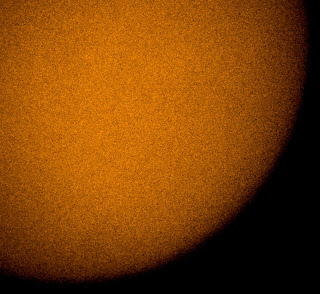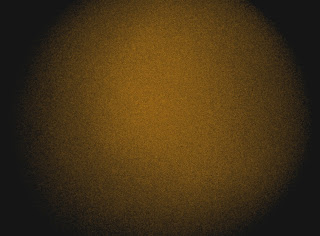March 31st 1700 GMT
A patch of clear sky opened up, so I did a solar hydrogen alpha shoot. The Sun, however, was still quiet, apart from the sunspot.
However, the full disc image revealed a prominence.
March 31st 1045 GMT
There was a lot of moving cloud around, so I did a binocular scan of the Sun. It was active and showed four distinct sunspots. However the real-time images on SOHO showed that they were active regions that split into many smaller sunspots that I was not able to resolve with my binoculars.
March 30th 1235 GMT
It was somewhat hazy but with sunspots showing on the professional observatories I just had to go out. I set up the Mak and DSLR at ISO 800 and 1/1000 second exposure. I took 99 frames. Unfortunately, the images were over-exposed and did not stack, so I processed a single image. The sunspots are visible but I was not happy.
I followed up with my PST to look at and photograph he Sun in hydrogen alpha light. The disc looked quiet, except for some sunspots.
March 27th 1510 GMT
The morning was cloudy but the cloud had thinned to a haze by mid-afternoon. I bin scanned the Sun and saw 2 sunspots, the first I had seen for ages.
March 26th 1210 GMT
This was my first session on British Summer Time. The weather was sunny but there was some haze. I waited for the Sun to reach maximum height before attempting a session with my Coronado PST.
I had seen a photo on Facebook of a flare and prominence. I could see the flare but not the prominence. I took some photos, hoping to get more detail after processing.
March 25th 2030 GMT
I left a camera outside, using the intervalometer to take frames while I stayed in the warm. I took a sequence of 75 overhead shots followed by another 75 aimed at Gemini. I used the same settings to take 75 dark frames.
The overhead shot was not a great success. Only alternate frames were any good, as I needed to use a longer inter-frame timer. Deep Sky Stacker and Microsoft ICE both introduced "ghost" stars. I eventually processed a single frame that caught most of Ursa Major, with Castor and Pollux at the other end.
The Gemini shoot was more successful, with 21 frames stacking in Deep Sky Stacker. I was pleased to capture the Beehive cluster (M44).
March 25th 1000 GMT
It was warm enough to go outside, despite my persistent cough. I checked the Sun in hydrogen alpha light and it seemed very quiet. I could no find any prominences nor could I see any large-scale surface features. I took some full disc and close-up shots.
March 21st 1110 GMT
I checked the Sun in hydrogen alpha light with my PST. As in "white" light, it appeared featureless. I took some afocal full disc and close-up shots.
March 21st 1035 GMT
I bin scanned the Sun but did not see any sunspots.
March 15th 2000 GMT
It had cooled down a little bit but it was warm enough to leave a camera outside snapping Orion. I meant to use an exposure time of 30 seconds but set it to 10 by mistake.
I used 18mm focal length and ISO 800. I took 70 frames and 70 dark frames. Deep Sky Stacker did not work, so I stacked 58 frames using Microsoft ICE.
March 15th 1840 GMT
As it was still warm, I did an outside shoot of Venus while cooking. I used the Mak and DSLR and took frames at ISO 800 and 1/4000th and 1/1000 second.
I tried using a 3x Barlow giving an effective focal length of over 4.5 metres and exposure of 1/1000 second. However, this did not show Venus, as it was probably under-exposed.
The best image came from stacking six frames at 1/1000 second exposure.
March 15th 1120 GMT
Although I was still less than healthy, it was warm enough and sunny enough for an outside solar hydrogen alpha shoot. I saw some disc detail but no prominences and the Sun was still generally rather quiet.
March 13th 1035 GMT
I did another indoor solar hydrogen alpha shoot in hazy conditions. The Sun seemed quiet.
March 13th 0905 GMT
I bin scanned the Sun through thin cloud but did not see any sunspots.
March 9th 0840 GMT
I bin scanned the Sun through thin cloud but did not see any sunspots.
March 6th 1330 GMT
I bin scanned the Sun under cloudy conditions but did not see any sunspots.
March 5th 0920 GMT
I did another indoor solar hydrogen alpha shoot. Conditions were less than ideal and the Sun was rather quiet.
March 4th 1430 GMT
I had another go at photographing the Sun with my PST from indoors but it clouded over before I could finish the shoot.
March 4th 1020 GMT
It is not normally wise to perform astrophotography from indoors but I was still feeling quite ill. The Sun was quiet in hydrogen alpha light, too. I took some full disc shots and random close-ups.
March 4th 0950 GMT
I bin scanned the Sun in clear conditions but did not see any sunspots.
March 2nd 1305 GMT
I bin scanned the Sun. Even though the single large sunspot and many smaller ones were visible on the Big Bear images, I did not see them through my binoculars.


























































